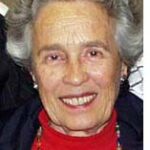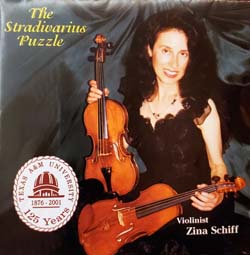Editor’s note: Eileen Wingard continues her series on the discography of her sister, concert violinist Zina Schiff, with embedded examples.

 SAN DIEGO — Joseph Nagyvary, the brilliant Hungarian-born Professor of Biochemistry from Texas A & M, had just finished delivering a lecture at Louisiana State University in Shreveport. His topic was his research into the chemical properties of Stradivari violins. This prompted one of his colleagues to suggest that he contact my sister, concert violinist, Zina Schiff, who was living in Shreveport at the time. Nagyvary immediately phoned Zina, they arranged to meet, and that encounter spawned performances, recordings, and a seminal TV appearance.
SAN DIEGO — Joseph Nagyvary, the brilliant Hungarian-born Professor of Biochemistry from Texas A & M, had just finished delivering a lecture at Louisiana State University in Shreveport. His topic was his research into the chemical properties of Stradivari violins. This prompted one of his colleagues to suggest that he contact my sister, concert violinist, Zina Schiff, who was living in Shreveport at the time. Nagyvary immediately phoned Zina, they arranged to meet, and that encounter spawned performances, recordings, and a seminal TV appearance.
Soon after they met, Zina traveled to College Station to perform a recital on a Nagyvary violin. The Biochemistry professor was a pioneer in the investigation of the chemical make-up, the preservatives, and the varnish of the woods used for the famous Cremona-made violins. The violin Zina played was the result of his discoveries. Supported by a grant from the state of Texas, Nagyvary invited Zina to accompany him at his lectures to demonstrate the fine qualities of his violins. One of her recitals was for the National Conference of the American Chemical Society.
Zina played the Sibelius Violin Concerto with the La Jolla Symphony, Thomas Nee, conducting, on a Nagyvary violin. That performance was filmed and became part of a PBS NOVA program, What Is Music. For her two debut CDs with the Israel Philharmonic Orchestra, Bach/Vivaldi and The Lark Ascending, Zina played on a Nagyvary violin. In honor of Nagyvary’s work and the 125th Anniversary of Texas A & M University, Zina was invited to present a recital at the Bush Presidential Library in College Station, where she alternated, playing on a 1697 Stradivarius and a 1991 Nagyvarius. Texas A & M also released a 2001 recording, The Stradivarius Puzzle, in which some of the selections are on the Stradivarius and others are on a Nagyvarius.
The Stradivarius Puzzle was actually recorded in San Diego with Mary Barranger, pianist of the San Diego Symphony and the San Diego Chamber Orchestra, as Zina’s fine collaborator. It includes the Adagio and Fugue from Sonata #1 for unaccompanied violin by Johann Sebastian Bach (1685-1750), Suite Italienne by Igor Stravinsky (1882-1971), arranged for violin and piano by Samuel Dushkin (1891-1976), and Suite Reb Mendele by Simon Sargon (1938-).
Zina became acquainted with Simon Sargon’s music when he sent her Suite Reb Mendele for perusal. He was the Professor of Composition at Southern Methodist University and Music Director at Temple Emanu-El in Dallas,Texas. Zina performed Sargon’s Suite Reb Mendele with David Amos and the Tifereth Israel Community Orchestra. She has also played the violin-piano version of the work in recitals, as heard on this recording.
The three excepts from The Stradivarius Puzzle are: Fugue from the Sonata #1 by Bach (track 2); Supplication (track 10) and Freilach (track 12)
from Suite Reb Mendele by Sargon.
In the liner notes, Joseph Nagyvary wrote: “Our violin, made in 1991, has a similar combination of focus and brilliance as a typical Stradivarius. One should not forget that the tonal beauty of both violins is also due to the exquisite artistry of Zina Schiff.”
*
Eileen Wingard, a retired violinist with the San Diego Symphony Orchestra, is a freelance writer specializing in coverage of the arts. She may be contacted via eileen.wingard@sdjewishworld.com
Such a wonderful and informative article! We have really enjoyed listening to the embedded pieces!
I read the article over a cup of coffee in a safe place and the beautiful music accompanied me on my walk home. Thank you.